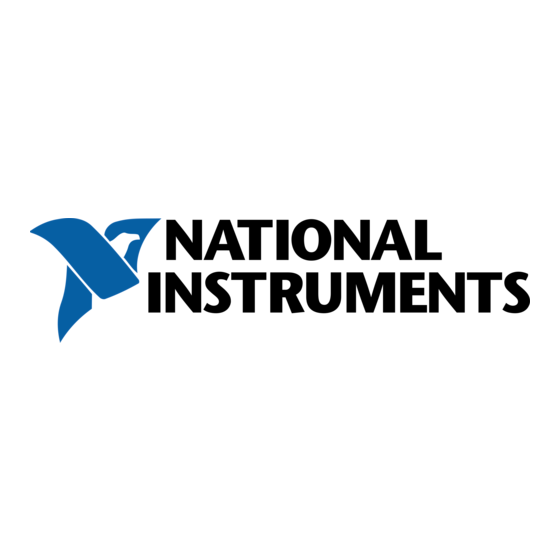
Table of Contents
Advertisement
Quick Links
Getting Started with the NI 7831R
Introduction
Note
If you are using LabVIEW but not the LabVIEW FPGA Module, you can create VIs
that run in LabVIEW to control existing FPGA VIs, but you cannot create new FPGA VIs.
This document explains how to set up the National Instruments 7831R
device.
The NI 7831 is an R Series reconfigurable I/O (RIO) device with 96 digital
I/O (DIO) lines, eight independent 16-bit analog output (AO) channels, and
eight independent 16-bit analog input (AI) channels.
Traditional I/O devices have a fixed functionality provided by an
application-specific integrated circuit (ASIC), but the NI 7831R has a
field-programmable gate array (FPGA) that allows you to define device
functionality and timing.
You can use the LabVIEW FPGA Module to graphically design the
NI 7831R timing and functionality without having to learn a low-level
programming language or a hardware description language (HDL)
traditionally used for FPGA design. With the LabVIEW FPGA Module,
you create or download a custom virtual instrument (VI) to the FPGA.
You can reconfigure the NI 7831R device with a new VI at any time.
You can use the LabVIEW Real-Time Module to communicate and control
the NI 7831R device while performing additional tasks, such as real-time
floating-point processing and data logging.
The NI 7831R device has Flash memory that you can use to store VIs.
You can configure VIs to load to the FPGA and to run when the device
powers up.
Advertisement
Table of Contents

Subscribe to Our Youtube Channel
Summary of Contents for National Instruments 7831R
- Page 1 FPGA design. With the LabVIEW FPGA Module, you create or download a custom virtual instrument (VI) to the FPGA. You can reconfigure the NI 7831R device with a new VI at any time. You can use the LabVIEW Real-Time Module to communicate and control the NI 7831R device while performing additional tasks, such as real-time floating-point processing and data logging.
-
Page 2: Required Items
LabVIEW Help is available in LabVIEW by selecting Help»VI, Function, & How-To Help. PXI-7831R with Windows 2000/XP Use the following items to set up and use the PXI -7831R with Windows 2000/XP. ❑ PXI-7831R device ❑ The following software packages: –... - Page 3 At least one cable and device for connecting signals to the PCI-7831R PXI-7831R with the LabVIEW Real-Time Module for ETS Use the following items to set up and use the PXI-7831R with the LabVIEW FPGA Module and the LabVIEW Real-Time Module.
- Page 4 PCI-7831R with the LabVIEW Real-Time Module for ETS Use the following items to set up and use the PCI-7831R with the LabVIEW FPGA Module and the LabVIEW Real-Time Module for ETS. ❑ PCI-7831R device ❑ The following software packages: –...
-
Page 5: Installing Software
If you are using the PCI-7831R device with the LabVIEW Real-Time Module for RTX, install the LabVIEW Real-Time module for RTX from the LabVIEW Real-Time CD. If you are using the NI 7831R with Windows only, it is not necessary to install the Note LabVIEW Real-Time Module. -
Page 6: Installing Hardware
This section describes how to unpack and install the PXI-7831R and the PCI-7831R devices. Note You must install the NI-RIO device drivers before installing the NI 7831R device. Unpacking The NI 7831R device ships in an antistatic package to prevent electrostatic discharge from damaging device components. - Page 7 PXI-7831R Installation You can install the PXI-7831R in any available peripheral slot in the PXI or CompactPCI chassis. Complete the following instructions to install the PXI-7831R device. Note You must install the software before installing the hardware. For software installation instructions, refer to the Installing Software section.
- Page 8 Before adding RTX support for the R Series device, close all NI software. Select Start»Program Files»Venturcom RTX»RTX»RTX Properties. On the Plug and Play tab, right-click NI-7831R and select Add RTX INF Support. Click the Apply button. RTX Properties returns a Warning dialog box.
-
Page 9: Removing Rtx Support
In the Device Manager window, select View»Resources by connection. In the Device Manager window, expand Interrupt Request (IRQ). Make sure that the NI PCI-7831R is not sharing an IRQ with any other devices. Refer to the Venturcom RTX Runtime Help for information about modifying a PCI device. -
Page 10: Connecting Signals
Connecting Signals The NI 7831R has two DIO connectors with 40 DIO lines per DIO connector, and one MIO connector with eight AI lines, eight AO lines, and 16 DIO lines. Figure 1 shows the I/O connector locations for the PXI-7831R and the PCI-7831R. - Page 11 Connections that exceed any of the maximum ratings of input or output signals Caution on the NI 7831R can damage the NI 7831R and the computer. NI is not liable for any damage resulting from such signal connections. Refer to the NI 7831R User Manual for the maximum input ratings for each signal.
-
Page 12: Cabling Options
Provides shielding on all AI channels and an overall analog shield to reduce digital-to-analog crosstalk. NSC68-262650 For direct connection of the NI 7831R to 5B and SSR analog and digital signal conditioning backplanes. Routes signals to connectors that attach directly to 5B backplanes (for analog signals) and SSR backplanes (for digital signals). -
Page 13: Where To Go From Here
LabVIEW FPGA VIs and host VIs. This document also provides examples for verifying that your software and hardware are properly installed. To access this document, select Start»Programs» National Instruments»LabVIEW»Module Documents. © National Instruments Corporation Getting Started with the NI 7831R... - Page 14 *323256B-01* are trademarks of National Instruments Corporation. Product and company names mentioned herein are trademarks or trade names of their respective companies. For patents covering National Instruments products, refer to the appropriate location: Help»Patents in your software, 323256B-01 Apr 04 the patents.txt file on your CD, or ni.com/patents.







Need help?
Do you have a question about the 7831R and is the answer not in the manual?
Questions and answers